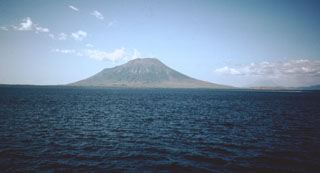Report on Lewotolok (Indonesia) — 26 June-2 July 2024
Smithsonian Institution / US Geological Survey
Weekly Volcanic Activity Report, 26 June-2 July 2024
Managing Editor: Sally Sennert.
Please cite this report as:
Global Volcanism Program, 2024. Report on Lewotolok (Indonesia) (Sennert, S, ed.). Weekly Volcanic Activity Report, 26 June-2 July 2024. Smithsonian Institution and US Geological Survey.
Lewotolok
Indonesia
8.274°S, 123.508°E; summit elev. 1431 m
All times are local (unless otherwise noted)
PVMBG reported that the eruption at Lewotolok continued during 26 June-2 July. White steam-and-gas emissions rose as high as 400 m above the summit and drifted N, NW, and W during 26-29 July. Emissions were not visible on 30 June. A white-and-gray ash plume rose as high as 300 m above the summit and drifted W and NW during 1-2 July. Summit incandescence was visible in webcam images during the week. The Alert Level remained at 2 (on a scale of 1-4) and the public was warned to stay 2 km away from the vent and 2.5 km away from the vent on the S, SE, and W flanks.
Geological Summary. The Lewotolok (or Lewotolo) stratovolcano occupies the eastern end of an elongated peninsula extending north into the Flores Sea, connected to Lembata (formerly Lomblen) Island by a narrow isthmus. It is symmetrical when viewed from the north and east. A small cone with a 130-m-wide crater constructed at the SE side of a larger crater forms the volcano's high point. Many lava flows have reached the coastline. Eruptions recorded since 1660 have consisted of explosive activity from the summit crater.
Source: Pusat Vulkanologi dan Mitigasi Bencana Geologi (PVMBG, also known as CVGHM)

